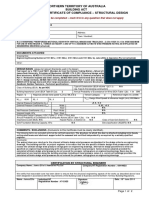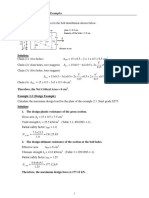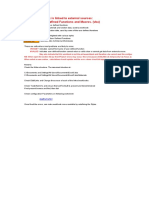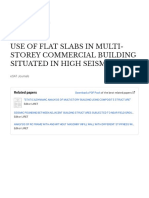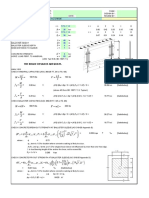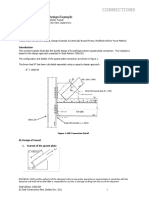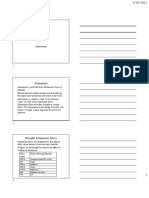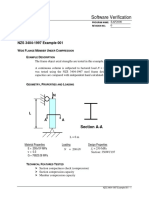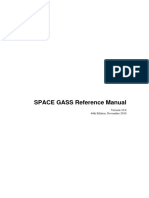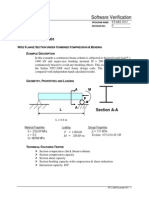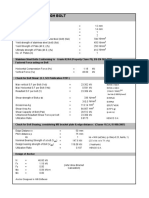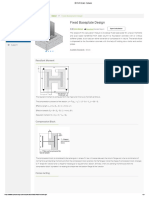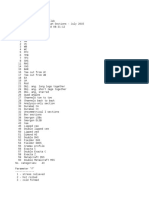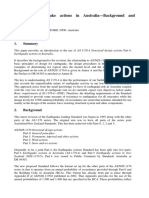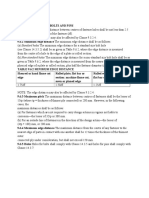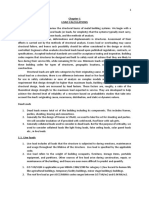0 ratings0% found this document useful (0 votes)
190 views47 pagesStructural Design With Wind Loading
Structural steel design with load combinations and limit states design. Steel Design Code AS4100 , Loading Code AS1170/0 General Principles, AS1170/1 Dead and Live Loads, AS1170/2 Wind Loads and AS1170/4 Earthquake Loads.
Uploaded by
seanyinCopyright
© © All Rights Reserved
We take content rights seriously. If you suspect this is your content, claim it here.
Available Formats
Download as PDF or read online on Scribd
0 ratings0% found this document useful (0 votes)
190 views47 pagesStructural Design With Wind Loading
Structural steel design with load combinations and limit states design. Steel Design Code AS4100 , Loading Code AS1170/0 General Principles, AS1170/1 Dead and Live Loads, AS1170/2 Wind Loads and AS1170/4 Earthquake Loads.
Uploaded by
seanyinCopyright
© © All Rights Reserved
We take content rights seriously. If you suspect this is your content, claim it here.
Available Formats
Download as PDF or read online on Scribd
You are on page 1/ 47
CIVIL 3111: STRUCTURAL STEEL DESIGN
SECTION I: LOAD COMBINATIONS AND LIMIT STATES
DESIGN
Ia) EXPECTED VALUES, EXTREME VALUES, AND FAILURE
Limit States Design is a probability based design method which (presumably) sets up
procedures in which all materials and all structures can be designed to a common
probability of failure. A failure rate of 1:10000 is nominally acceptable as an ‘act of
god”, and failure rates which are smaller than this figure are acceptable as ‘accidents’.
Failure rates in excess of this figure are likely to be caused by known design or
construction faults, and are not acceptable as accidents.
To assure that an acceptable level of safety is achieved in design, limit states codes are
divided into ‘material standards’, e.g, concrete, steel, timber, glass, etc., and into ‘loading
standards’, e.g. dead and live loads, wind loads, earthquake loads, eto. In this course, we
will use the Steel Design Code AS4100 and the Loading Code: AS1170/0 General
Principles, AS1170/1 Dead and Live Loads, AS1170/2 Wind Loads, and AS1170/4
Earthquake Loads
Structural Steel (AS4100)
Structural steel is a low carbon steel with very high duotility. A typical stress-strain
diagram is shown below:
ome
aso
300
wala wing Claw se” Tleaw Vises Waa Wass Wana atocs — Exton*
For the purpose ofthis course, all Australian produced steel will be grade 300+, which
has a nominal yield strength of 300MPa and a nominal ultimate strength of 430MPa.
Values of yield can vary from batch to batch, and the steel code uses @ factor of 0.9 to
give a minimum expected yield strength of 0.9 x 300 = 270MPa where the failure is
ductile. Ultimate strengths are more inconsistent, and the steel code uses a @ factor of
0.8 for what is considered a brittle failure. Where the material is not manufactured under
lose tolerances, there is a possiblity of lower strengths being produecd by faulty
manufacture. In these cases (e.g. welding) even lower @ factors are recommended
(0.6). These are specified in Table 3.4 of AS4100, ‘The ¢ factor is known as a ‘capacity
factor’.
422 Strength
@)
‘The diagram below shows a Gaussian Probability Distribution for ductile and brittle
failures
i \ Deble / \ Bottle
B50 50 «880 pee eee
Loads and Load Combinations
Loading on a structure consists of a combination of dead loads (permanent attachments to
the structure, e.g. beams, columns, partitions, cladding, tiles, walls, floors, plumbing
conduits, lighting, insulation), live loads ( movable objects within a structure, e.g
people, partitions, furniture, floor coverings, machines ), wind loads ( pressures on the
windward faces, suctions on the leeward, side and roof faces ), and earthquake loads (
inertia forces duc to lateral motions). All of these loads have characteristic differences.
Dead Loads are always on the structure, so that combinations without dead load are
impossible. But dead loads are often estimated by the designer (since the actual member
sizes are not known until the design is completed). ‘Therefore, the code uses a factor
of 1.20 or 0.9 to represent the limits of uncertainty in the designer’s estimate, AS1170/1
gives load combinations for the strength limit state in AS1170.0 Section 4.2 and TABLE
41
TABLE 44
Me sie combinations for the wlkimate linic states used in checking srength (Gee SHORT-TERM, LONG-TERM AND COMBINATION FACTORS
Slause 7.2.2} shall be as follows, where the loxg-erm and combination factors ae given in
Table aaemerite
8) & = (1336) fexmana ation aly (es oe apply co pesuesing o
BE, = 1126, 1.50} —_permanentand imposed action enero
© 6 © 1126.14) permet loge imposed aon cee a. i
® E = (2G, We 0) pormanest, wind and imposed action oe 07 oe a
2B = (080,44) permanent and wind action reversal vesting or ou oa
1 Ey = (G6, V1 permanent earthquake and imposed action Bex o a os
BE = (1.26.5. ¥4Q] permanent action, acsons given in Clause423 and St vo a6 v6
Inposed action otter 10 os |
®
‘Note that 120G accompanies live load (both downward) to give a maximum downward
combination and 0.9G accompanies wind load (dead down and wind up on a roof) to give
a maximum uplift combination.
Live loads are intermittent loads on a structure, which have a nominal maximum value
which occurs once in a 50 year building design life. Live loads are more difficult to
estimate than dead loads, and the code uses a factor of 1.5 to account for that
uncertainty. Itis important to understand that live loads do not occur in any fixed
pattern, but can be moved at will to apply to any part of a structure. Consider the simple
structure below:
thr dae
tell | freestureug I I ApSSOL SLAIN
sa/on 8
09G es ~~ “>
eee
15Q
ss
Dar oe
a
$0, 2
Max Combination: 1.206 + 1.5Q; } ee ON
‘The worst moment in the roof oceurs for the combination 1.20G-+ 1.5Q) , where the live
oad Q is applied only to the end cantilevers (not over the middle). Note that the load
combination 1.2G + Wu + 1.5Q does not appear anywhere in Table 2.2 of AS1170.1.
This is because the probability of worst live load with worst wind (both 1 in 50 year
events) occurring on the same day is too small to consider. Instead, the combination case
is 1.2G+W,+0.4Q, which considers a partial live load with maximum wind,
Live loads are also very dependent upon area, It is very possible that a small portion of a
building will be highly loaded ( e.g. people watching a sporting event or pallets stacked
in one area) but itis less likely that a complete building will be highly loaded
everywhere. ASI170/1 provides for reductions of live load over large areas in Section
3.4.2 and AS1170/2 provides similar reductions for wind loads in Table 5.4.
Recommended material weights and live loads are given in Appendix A and Appendix B
of ASI170/1
Wind Loads are calculated in Sections 3 to 5 of AS1170/2. ‘These are based on a wind
pressure which varies with height and which is influenced by terrain. AS1170.2 defines 4
types of terrain: 1 = open grassed fields or salt las, 2 =rural areas with trees and
scattered buildings (and open ocean), 3 ~ suburban areas with low-rise buildings, and 4
~ es with hob rie buildin,
wee
= '
‘The base wind pressure is calculated from _p(z) = % pV(z)*CpArea and the relevent
Cp values are given in Section 5 of AS1170/2.
Earthquake loads are based upon a percentage of the weight of the structure applied
horizontally to a building in an inverted triangular fashion. . The basic formulae are given
in Section 6 of AS1170/4. These can be summarised by:
Vins = (CSIR) G where: G = Dead weight + 40% Live Load
C= 1.25a/T”* a=0.09 T= period
S~ 1 for solid ground
v = 1.25 for soft sand
5 for clay
5 for normal steel or concrete construction
= 8 for ductile earthquake construction
5 for reinforced masonry construction
.5 for unreinforced masonry construction
—»
a
af
a
Meae = V x 2/3 H
When the designer has selected his @ factors for the material and his 7 factors for the
loading, failure is defined as the region of overlap between the loads ( actions ) and the
resistances ( materials and sections ). Nominally, this overlap should produce a 1:10000
probability of failure.
Consider the case of a 20m tall building (6 floors) with a 24x24m plan area in Terrain
Category 3. We will begin by assuming a felt and gravel non-trafficable roof with main
steel girders running North-South at 6 m spacing and purlins running East-West on 1 m
spacing. The vertical columns are on a 6 m grid East-West and an 8 m grid North South.
The floors are 100 mm concrete slabs on steel girders.
Loads on the Roof:
Dead Load: — felt/gravel
Insulation batts
Purlins 3kg/m @ Im
Girders 40kg/m @ 6m
Total
‘Non-trafficable Live Load:
‘Wind Uplift: 0.6x(0.94x46)"x-0.9/1000
Design of a Purlin:
——
0.43 kPa,
0.05 kPa
0.03 kPa
0.07 kPa
0.58 kPa
0.25 kPa
-1.01 kPa
Interior Purlin
Design of a Main Girder:
W=(0.96+Wa)
9x0.51-1.01)xlm =-0.55 kNim
* Note that purlin does not carry the Girder
Exterior Purlin
W = (0.9x0.51-2x.1.01)xlm 56 KN/m*
* Note local pressure multiplier of 2.0
Interior Girder
W = (0.9x0.58-1.01)x6m = -2.92kN/m
Exterior Girder
Wy = (0.9x0.58-1.5x1.01)x3m = -2.98 KNin*
* Note local pressure multiplier of 1.5
Loads on a Typical Floor Girder (North-South):
Dead Loads: Conerete Slab 100mm thick 2.4 kPa
Suspended Ceiling 0.4 kPa
Lighting and Ducting 0.2 kPa
Total 3.0 kPa
Live Loads: Offices+Corridors
35kPa
‘Tributary Area = 48m” Area Reduction: R= .3 + 3/f48'= 0.733
Reduced Live load = 0.733 x 3.5 = 2.56 kPa.
(1.2G+1.5Q) —= (1.2341 5x2.56)x6m = 44.6 kN/m
Loads on a Typical Interior Column:
Tributary Floor and Roof Area= 8 mx 6 m= 48 m?
Roof Load = (1.2x0,58+1.5x0.25)x48 = 53 KN
48,R 1.2x3+1.5x.73x3.5)x48 + 53 =410 KN
.61) = (1.2x3# 1. 5x.61x3.5)x96 + 53 = 706 KN
144, R=0.55) = (1 2x3+1 5x.55x3.5)x144 +53 = 987 KN
Floor 2 (A= 192, R= 0.50) = (1.2x3+1.5x.50x3.5)x192 +53 = 1248 kN
Floor 1 (A= 240, R= 0.50) =(1.2x3+ 1.5x.50x3.5)x240 +53 = 1547 KN
Maximum Ground Floor Column Load = 1S47KN
Horizontal Loads Due to Winds:
For Perth in a suburban terrain, we use a 1000 year return design wind speed of 46m/s for
an importance level 3 building. The building width is 24m and the effective C, is +0.8 on
the windward face and -0.5 on the leeward face. Since pressure on the front and suction
on the back give additive forces, the overall building C, is 1.3. This gives:
Zz v@ “pVBC,
20m | 43.2m/s | 34936Nim
10 }39.0 28473
0 [39.0 28473
We can caleulate the lateral load on the foundation and the moment on the foundation
using the trapezoidal rule of integration:
Viase = 10/2 ( 1x34936 + 2x28473 + 1x28473 )= 602 KN
Mbese = 10/2 ( 1x20x34936+2x10x28473+1x0x28473 ) =6340 KN-m
Horizontal Loads Due to Earthquake:
We will begin by estimating the building frequency to be 1 Hz (T= L4-We will assume
it is normal steel! construction with a soft sand foundation (R5-45,8 = 1.25). The
building is in Perth (a = 0.09)
C= 1,25x0.09 = 0.112
S=125
R=45
G sref 5 floors = [ (0.58 + 0.4x 0.25) + 5x(3 + 0.4x3.5) ] x 24°
= 13x10? KN
‘Viese = 0.112x1.25/4.5 x 13x10° = 404
CIVIL 3111: STRUCTURAL STEEL DESIGN
SECTION II: DESIGN OF TENSION MEMBERS
Ma: Concentrically Loaded Tension Members
Tension members are conceptually the simplest members to design, since they are under
relatively uniform stresses, and they are never plagued by problems with buckling
(instability). Tension members are also very stiff, and do not (generally) require the
consideration of deflection. Nevertheless, tension members require the designer to
consider a relatively large number of failure modes. We will begin the design of tension
members with those relatively special members that can be loaded through the centroid,
which is known as concentric loading,
A concentric load produces uniform axial stress (no bending), o=P/A. We will
consider two critical sections under tension, a) at the mid-length of the member where
there are no bolt holes, and b) at the end of the member where the member is connected
by bolts to another member:
200UB22
Avgross = 2870 mm™
Agen = 2870 ~ 2x22x5
= 2650 mm?
Ageoss Arnett
It is apparent that the stress at the end is higher than the stress at the middle, since the x-
section has lost material where the bolt hole is cut. The failure modes for the two
sections, however, are very different. The middle will fully yield, so that the member
will elongate over its entire length, leading to excessive deflections. Therefore, itis
logical that the failure stress is the yield stress, cy (=f, in AS4100 ) = 300 MPa. This
failure mode is described in clause 7.2:
Nea Ash
Atthe ends, the higher stresses would reach yield before the middle, but the length (that
of a bolt hole) is too short to cause large deflections. Therefore, the ends can reach
ultimate at which point a tearing failure occurs. It is logical that the end failure relates to
the ultimate stress, oun (= fu in AS4100 )= 430 MPa. This is also included in clause 7.2:
N
85K An fe
For concentric loads, kx= 1.0. The 0.85 appearing in the nett section provision allows us
to use @ = 0.9 for all tension provisions, noting that the brittle end failure should be =
0.8. There are also localised failure modes around bolt holes which cause tearing or
ripping of the section:
me , bo %
‘These latter failures are normally prevented by minimum bolt hole and edge distances as
shown above. In all tension applications, ¢ = 0.9. The design capacity of the section,
then, is given by @ Ny Clause 7.1.
What is the design tension capacity of the 200UB22 shown above:
GN C= Ag fy = .9x300x2870 = 774000N = 774 KN
ON. = 90.85k: fa: Aa =.9.8531x430%2650 = 871700N = 871 kN
The smaller capacity controls, ie. the section yields in the center before it tears at the
ends.
Ub: Eecentrically Loaded Tension Members
In order to have uniform axial stress, o= P/A, a member must be loaded through its
centroidal axes. In many cases, this is both expensive and impractical. Consider the
simple angle section below, where the centroidal axes do not fall on the angle itself. To
load this member concentrically, it would be necessary to use a connections like the ones
shown below:
Ms ne
In this latter case, the member is placed in bending as well as tension, particularly at the
ends of the member. Combined tension and bending increases the stress and reduces the
capacity of the section. Thus, while it is cheaper, there is a loss of capacity as a result
Consider the solid rectangular section below with a height (h) and a thickness of unity
(HD), which is loaded in tension on the bottom face. Elastically, the stresses in the
section are given by:
AreashxI=h Tom 1 xh12=W2
Axial Stress: 6, = P/h Bending Stress: 6, = M y/lax
= Ph? x h/2/H/12
=3P/h
'
ate oe %
o™=Pih(1+3)=4P/h
In the example above, the section could only carry % of the concentric tension when the
section reaches first yield, That is a very high price to pay fora cheap connection. The
situation improves somewhat if we let the member fail plastically rather than elastically.
Consider a plastic stress block which changes from compression to tension a distance (y)
above the bottom.
T=R-F.=o,(y)-o(h-y)
= oy(2y-h)
Mase Fiyl2~Fayt(h-y)2)
ry Y'/2 - oxfh-y)(hty V2
oy (yh)
To equal a pure axial pull at the base of the section, the moment about the base must be
zer0:
Mosse 0 = y*— 7/2
This is a quadratic equation which gives y= 0.707h and (T/Tw) = 0.414
In plastic failure we can take 40% of the concentric load, which is an improvement on the
elastic case. Plastic solutions like the one above are yery tedious, and AS4100 provides
correction factors, kx, for eccentric connections in Table 7.3.2. Consider an elastic angle
seotion witha log length of (h) and a thickness (tI)
ae
yoy
T= 5/24h°
o™* = T/(2h) + Th/4 x (Bh/4) / (5/24h? )= TH(2h) x [1 + 9/5 ]=2.8 T(2h)
Ancelastic stress block gives a ( 1/ 2.8 = 35% ) capacity at the first yield in the member.
‘The plastic assumption provides an alternative. Again, the moment about the base must
be zero if a pure tension is applied at the bottom of the angle.
WA
Fe=oy(h-y)
hg Rtq- Fa= oy)
Fe = oy(h)
: -Fra,
Fa
%
Moe = 0 = Fe(y#(h-y)/2)— Fu (9/2) - Fa(0) 7
0 = (hey) (vH(b-y)2) - Gy) (9/2) = oy (2-¥*)
‘this is again a quadratic equation, which gives y= 0.707h and T= Fy + Fa -Fe=
oy hty-(h-y) )= L414ay h, which is 70% of the ultimate tension.
‘Comparing the (above) theoretical value with the AS4100 correction factor in Table 7.3.2
leads to an interesting conclusion. For an angle section, AS4100 allows 85% of the
concentric capacity, not the 70% value that the theory (above) predicts. This implies that
‘the AS4100 values are based on test results rather than on thes ‘Test results on ‘real’
tension members use splice plates with some resistance to bending. This bending
‘moment at the base of the section leads to extra capacity, which is allowed for in the
code.
We can now proceed to calculate the capacity of members based on failure at both the
middle of the member and failure at the member ends:
Calculate the capacity of a 75x75x6 angle with 20mm bolts in the angle and splice plate:
AS = 867 mm? A™ = 867 - 22x6 = 735 mm?
Note (above) that a 20 mm bolt requires a 22 mm hole for construction tolerance,
Using Clause 7.2 of AS4100:
‘Yield Failure @ Ni = 0.9x300x867 = 234 KN
End Failure @ N= 0.9x0.85x0.85%430x735 = 205 kN
‘The section fails at the bolted end at 205 KN.
)
‘There is a general tendency in design to try to keep connections and splice plates as short
as possible. In this case, it is often economical to stagger the bolt holes as shown below.
Ina staggered bolt pattern, the end tearing failure must be considered along several
planes: 2528
Ie: Nett Areas and Staggered Holes
get? = 723 = 2x22x7.8 Agel = 723 ~ (3x22 ~ 2x25/4x25) 7.8 =
= 379.8 mm? = 305.7 mm:
The correction factor in AS4100 for staggered holes is given in Clause 9.10.3, where the
nett area is the gross area minus all holes on a failure line plus the sum of (s"/4g)t_ for
each staggered line of the pattern,
Id: Bolt Sizes and Numbers of Bolts
There are two types of failures of bolts in tension connections: a) a shear failure through
the bolt itself, and b) a bearing failure in which the bolt clongates the bolt hole (Le. a
failure of the plate or ‘ply’). These failures are given in AS4100 as Clause 9.3.2.1 and
9.3.2.4. Using these clauses, it is possible to construct a table of bolt capacities. In all
cases, we assume short connections so that k; in Clause 9.3.2.1 is 1.0,
Note that the computed bolt values below contain the capacity factor @ for both shear and
bearing failures.
Mild Steel Bolts f.=400 = 0.8 for shear = 0.9 for bearing
Diameter |] Shear Shear Bearing
One Plate Two Plates | 4mm Plate 6mm Plate 8mm Plate
12 224kN 44.8KN S9kN 89kN 118kN
16 39.8 796 B6 118 157
20 622 124.4 98.3 1475 196.6
24 89.6 179.2 118 17 236
High Strength Bolts f,=830
12 46.5KN 93KN
16 82.5 165
20 129 258
24 185.9 371
SOKN
78.6
98.3
11g
89kN
118
147.5
77
118KN
157
196.6
236
CIVIL 3111: STRUCTURAL STEEL DESIGN
SECTION I: DESIGN FOR PURE COMPRESSION
Ia: Euler Buckling and Effective Lengths
Design of steel columns is almost universally controlled by buckling failures, since
columns are generally long and slender. Buckling failures are described by the famous
Buler Buckling Formula shown below:
P* = WP EIAKLY
and the code form which can be derived from 1° = /A
PN = BIKLYVA = WELTY
‘The term (KL/1) is known as the section slenderness. The ‘effective length’ of a column
is defined as the length of the half sine wave in the buckled shape. There are several
exact solutions for which the effective lengths can be shown diagramatically:
Cases with No Sway: Top and Bottom both restrained laterally
open jet
Pin— pin: So eee eee eee eet ‘ .
ST 4
oe
Reet Wa
Pin— fix: : acceaeareaa é
tow
RLF. ra
keke SL
Cases with Sway: Top moves laterally relative to the bottom t
eee aya jo
eter eee 7
Pin= pin oy f= f }
— rire
Pin fix Sea eee eee eet rye tes
ize {I} / ;
oT
4 SN ees cme
Fix fix
FoEEEeeeE eee eee eee eee eee
Rls Gb> Vat 20
Understanding Sway and No-Sway is crucial to the design of building systems. In many
low-rise buildings it is economical to allow the columns to bend under the action of wind
and earthquake loads, so that the building moves horizontally (it sways). To resist the
wind loads by bending, itis necessary to align the strong direction of the column in the
direction of the wind, The columns are connected to the beams by moment resisting
connections to form a ‘moment resisting frame’:
a ye Frat
Itis not generally feasible to resist wind loads in the perpendicular (weak) direction by
column bending, since in the weak direction the column is both too weak and too
flexible. In this direction, the column is generally braced (no sway). In this direction, the
beam to column connections and the brace connections are generally pins (non-moment
carrying).
ats
e a
pel eeeee
tS
JT wok ehccohen
A typical moment resisting frame is shown below in which the column has an effective
length of KL, = 2.3x6m = 13.8m (sway) and an effective length of kLy=0.5x6m = 3m
(no sway) (see effective lengths via AS4100 in the next section).
end elevation
Site Elevation 7
" We
flo SuAY
wae ¢L
IM: Calculation of Effective Lengths for Non-standard Cases
In most practical situations, columns are neither pinned nor fixed, but are attached to
other members (beams) which provide some end restraint. A pin end is simply an
infinitely small beam and a fixed end is an infinitely large beam, AS4100 contains two
graphs, Fig, 4.6.3.3 (a) and (b) for cases of no sway and sway. The graphs are used in
conjunction with modifying factors in Table 4.6.3.4. The theory behind these two graphs
is derived from the tendency of the joint to rotate (due to columns buckling) and the
tendency of the beams to resist rotation (due to bending). There is a factor at each end of
the column, y, which calculates the ratio of column rotation to column restraint ( [2 EV.
cotence) / [EEWL teana). The term EVL is characteristic of all expressions which relate
‘moment to rotation:
Case Moment Virtual Work Expression
7 ‘
"GEE memerty 10s SME of, As he
ae
eo é (32 2
eran te acta) ror S OM ge Ms NE &
ca ton Me
"CED nem 2028 Em Orme Ms tye
“ ca = MC % z 2 SMC 2H, 2M H
ce MEMO) 20% SHCEMI,, os BE me CEO
As an example of a building with no requirement for modifying factors, consider the
building below and column (g-k) on the ground floor.
Sway Building
neues : Bee
| 2800831 3
‘aiove 32
e e 9 n
25qv031 ~] 3
: ‘ he
& £ &
P= (2 x 44.5/3)(2 x 63.2/8) = 1.87
poem = 10,
kKL=21x3=63
‘Consider the same building with pin joints in its central bay:
‘Sway Building a :
?P Pe
x e jot
Pa tere
fe ? , 3 3 7
io w & .
P= (2 x 4.5/3 x 63.2/8) = 3.75
ye = 10
KL=2.45 x3 =7.35
In the example above, a pin at the column face means that there can be no moment,
resistance, and the beam is not counted. A pin at the far end of the beam, however, still
provides some moment restraint and requires a modifying factor (B ~ 0.5).
Mle: The Effective Column Buckling Stress (0 = af)
Euler buckling theory assumes a perfectly straight column with no misalignment of the
loads with respect to the centroidal axis of the column. In practice, all columns have
some construction tolerance and some inherent residual stresses from the rolling mill.
‘This means that columns have initial stresses (imperfections) which affect the ultimate
@
failure of the column. Extensive experimental work from the 1940’s to 1970"s produced
empirical curves to account for imperfections and the method of manufacture:
°
oy Yielding Failure =o, A
Imperfect Columns: Buckling Failure = 2 EV(kL)”
Ne= Oe fy A
hr
AS4100 has 5 categories of columns, for which we (in this course) are only interested in
2: a= 0 (UB and UC sections) and a = 0.5 (Channels and Angles). These categories
are represented as columns of a, factors in Table 6.3.3(3).
INd: Effective Sections in Compression
Some members which are used for columns have either thin webs or thin flanges or both.
“This is true of UB sections, where the beam web is usually very thin to minimise weight.
When these members are used as columns, these thin sections buckle locally as shown
below:
Buckle Pattern Stress Distribution
f
Yields First. 1 |
‘Where local buckling occurs at or below the section’s ultimate load, the segment that has
buckled will carry less than its full load. Account is made for this loss of capacity by a
form factor, kr , which reduces the buckled section to an ‘effective section’ as shown
below:
‘Note: Values of (kp) can be found in the BHP Section Manual for UB’s and UC’s
‘The factor, ke, appears in the effective slenderness of the column in Table 6.3.3(3):
de (KLIt) ke 6/250
‘The last term in the equation for Aq arises due to the table being ‘normalised’ to 250
grade steels (Australia pre-1998),
@)
CIVIL 3111: STRUCTURAL STEEL DESIGN
SECTION IV: DESIGN FOR BENDING
IVa: Section Capacity in Bending
In earlier design codes, the stress in a beam was assumed to be elastic, and failure was
defined by the moment at which the outer fibre reached yield. The new limit state code
allows for a failure where the entire section reaches yield. Note the different stress
blocks and moment capacities for a rectangular section below:
wey ate
e : c
Blastic | | la Plastic * 4
+-T fe
=
Strain Stress Strain Stress
C= 4 bh? oy C= bh2o=T
d=23h d=12h
M=Cd= 1/6 bh’ oy M=Cd= 1/4 bh’ oy
‘The elastic relationship gives M=Z oy, where Z = 1/6 bh’, and the plastic relationship
gives M= So, where $= 1/4 bh’, Note that the BHP Sections Manual lists both Z and
S for each section. A rectangle (above) is a very inefficient section in bending, and that
is characterised by a 50% increase in S over Z. I beams (UB Sections) are much more
efficient in bending, and the typical UB section has only 12-18% difference in Z and S.
Like columns, beams can buckle in their webs and in their compression flanges before
the full yield moment is reached. In this case, AS4100 presents a reduction of capacity i
Clause 5.2.4 in terms of an ‘effective section modulus’ Z°™.
Z75x10° ok)
@
If the beam in the example above had been controlled by strength rather than deflection,
‘we would have required more bracing, probably at the 1/3 points of the span.
IVf: Web Failures in Beams
‘An ideal UB section would have the thinnest web possible, since the web is a rectangular
section in bending, and is very inefficient. Note in the BHP Section Manual that the
webs are much thinner than the flanges. Thin webs are unlikely to reach full yield before
buckling, so local buckling of the web becomes a significant design problem. This
problem is most critical at points of support or points of concentrated load:
Failure By Local Yielding
‘When a concentrated load or reaction is placed on a flange, the web (which supports the
flange) is placed in compression. Since the web is thin, the local stressed under the load
can cause local yielding. Shown below is a moment connection with yield failure under
the compression flange:
ao
7 ©
as
25008 25 a
AS4100 calculates the capacity of a web in Clause 5.13.3 and Fij
5.13.1.1. In this
clause, an ‘effective bearing area’ is defined by the dimension by; in which the
concentrated load is
ispersed through the flange. For the problem above
bye = 8 + 2.5 x (8420) ~ 78mm
Roy = 1.25 x 78 x 5 x 300 = 146 KN
Rey = 0.9 x 146 = 131 KN < 344 KN (n0 good)
@3)
‘Once we have satisfied yield, we must check further for web buckling. In Clause 5.13.4,
buckling is equated to column buckling on a height (h) for a rectangular web section of
dimension byty defined at the mid height of the web. Again, for the problem above:
te C= 1i2b0/bt=C/12 = 2.08
Ja = 232/2.08 300/250 = 176
= 0.224
9 x.224 x5 x (784117) x 300
593 KN <344 KN (no good)
Anse
If the web is insufficient to carry the concentrated loads, it is common practice to add
stiffeners, as shown below. The stiffeners increase both the bearing area and the buckling
moment of inertia. Again, for the problem above:
60x8 Plate both sides Failure by Yielding
344 (ok)
Although itis rare for a UB web section to buckle under uniform loading, large plate
girders (welded sections) typically have very thin webs which are subjected to buckling
in shear, Shear buckling is covered in Clause 5.11.5.1 and 5.1.5.2
CIVIL 3111: STRUCTURAL STEEL DESIGN
SECTION V: DESIGN FOR COMBINED TENSION,
COMPRESSION, AND BENDING
Va: Tension and Bending: No Axial Buckling
If we were considering only elastic stresses, we would write the condition for yield in the
section (See also Section 2) as:
Oy >= Obend + Gaxiat
or 1 >= oteng / Oy + Gast /y
This expression plots as an interaction between bending and axial load, and is linear
Sexist /y
1.0
Unsafe
10 heat / Sy
Since AS4100 is a limit states code (ultimate not first yield), the form of the interaction
equation is re-written in terms of ultimate moments and ultimate tensile forces
Axial Only Nt= oN Ne/QN <1
Bending Only M* = 9M M*/@My=1
Combined 1 >= N*/gNt + M*/QMy
Rearranged MP/QMy <= 1 -N*/QN
M* <= @Mby (I -N*/@N,) Clause 8.4.4.2
The only difference between ultimate and allowable is the real form of the interaction
diagram. For Plastic failure, the interaction diagram for a rectangular x-section is shown
below.
Max= oyb(yh-y) Par = oyb(h-2y) ty ¢
s Me
THe %
M*/@ My
10
Coole,
— Prhe Theory
1.0
NON
The ultimate interaction diagram is not linear, but Clause 8.3.2 is. Therefore AS 4100 is
conservative in its treatment of combined actions ( itis a price paid for simplicity ).
Vb: Compression and Bending: Amplification of Moment (M**= 6 M*)
‘The most important difference between tension and compression is that tension tends to
straighten imperfect members, and compression tends to increase the imperfections in
members. If the imperfection is a bend, the increase in deflection automatically creates
an increase in bending moment. Thus, any initial bending (M*) caused by static loading
(first order structural analysis), will be increased if compression forces act on the
member. This phenomenon is called the amplification of moment due to buckling, and is
a second order phenomenon in structural analysis. The amplification can be related to the
ratio (P/P") in the member ( or N¥/N, in AS4100).
‘The amplification factor can be derived from a simple rigid columa/spring .
Perfect Column: i Free Body:
P P
a Stes
7
“
af
“1
it
i! i
‘
if
YM.~0 = (P38 -KSL) (P-KL)8=0
PT=KL
Imperfect Column: Free Body:
Pe
3 ja— KS $0)
°
3M,=0 = (P8-K[S-3JL) (P-KL)8~KL 8,
(@-P™)8 =-P™3, 8 =-P%5, /(P-P™)
8-8 €1/(1-P/P) } Mee =M+ (1 /(1-P/P®) }
The multiplier { 1/(1- P/P*)} = {1/(1-N*/N.)} is given in Clause 4.4.2.3 for sway
buckling, and appears with a modifier, ¢m = 0.6 —0.4 Bm , for no sway in 4.4.2.2.
It is important (above) the value of P™ be calculated from buckling in the strong axis of
bending ( Ix. ), since it is only efficient to use I-beams (UB's) bent about their strong
axis, This will be true even if the buckling is in the weak axis direction since the weak
axis becomes a combination of axial buckling in the weak direction, and lateral torsional
buckling due to strong axis bending.
Ve: Buckling in the Di
ion of Bending: In-Plane Buckling
The first case of buckling under combined actions is the case where the structure moves
laterally in the plane of the frame, and continues to move in the plane when moment
amplification and axial effects are taken into account. This is shown schematically
below:
et
@
In the case of in-plane failure, lateral buckling is not considered. Thus, the bending is
controlled by @M, (not by @ My ). The axial component is controlled by @p Nex in the
plane.
Mt =8 Mt = 9 Z.(1-N*/QNa )
‘This equation can be found in Clause 8.4.2.2 of AS4100.
In examining this equation, itis clear that if the column is unsatisfactory for pure
compression, N* > @ Nex, then the r.h.s, of the equation becomes negative. This
would be an automatic indication to use a larger member or to add more bracing,
However, Clause 8.4.2.2 has a sub-clause for N. which says (we) are allowed to use
effective lengths less than one (as if the column were non-sway).
The sub clause should only be used affer the column has been checked for pure
compression (no moment). This is because a failure under pure compression must still be
prevented to satisfy Section V of AS4100. After the column has passed Section V, the
cffcctive length can be reduced for Section 8! This is a somewhat controversial sub-
clause, that can only be found in the Australian Code; it has been rejected by the Euro
Codes and the North American Codes.
Vd: Combined Lateral Torsional Buckling and Axial Buckling: Out-of Plane
Failure
Before a design is complete, the possibility of bending moments causing failure out of the
plane of bending must be considered, Out of plane failure is shown schematically below:
. 7 44
failure
AS4100 considers out-of-plane buckling in Clause 8.4.4.1
M**=5M* = oa, GmfyZ-(1-N*/@Ny )
Where the only difference is the inclusion of M, and Ney.
‘Ve: Sample design for combinied compression and bending
Consider a two-story office building and the bottom story column BE. The building is
unbraced East West (sway) and braced North South (no sway), Column BE is subjected
to an axial load of 420 KN and a bending moment of 25 kN-m.
ok 3
estetien
t
Y
fe at
1) Calculate M**: y= (2x22.2x10°/3000)/(2x63.2x10°/6000) = 0.702
"= 10 (pin) Sway KL = 1.85L = 5550 mm,
No = (x? 2x10° x 22.2x10%/5550") = 1422x10° N
8 =1/(1 —420/1422) = 1.42
M** = 1.42x25 = 35.4 KN-m
2) Check Pure Compression In Plane
KL/t, = 5550/68.4=81 4, =81 300/250 = 88
= 62 @Nex = 0.9 x.62 x 3004730 791x10°N (ok)
3) Check In Plane with KL = 3000 and 2,=44 300/250 = 48 and a,=.869
@ Nex = 0.9 x 869 x 300 x 4730 = 1109x10° N
38.1x10° <=
.9#300*310x10°x (1 — 42071109)
&)
<= 52x10°N-mm (ok)
3) Check Out of Plane with KL = 3000 axial and L, = 3000 bending
KLity = 3000/38.5 = 77.5 =775 300/250 = 85
1, = 645
@ Ney = 0.9 x 645 x 300 x 4730 = 823x10° N
L=3000 M,=93x10° M.= 194x10°
= 0.6 { (93/194 +3 - 93/194) } = .75
Gg = 17X25 | 6.25" + 125° + 18.75 = 1.81
0404 = 1.36 limited to 1.0
38.1x10° <= 0,9x1x300x310x10°x ( 1 - 420/823 )
<= 40.9x10° (ok)
The section passes all checks and is satisfactory.
CIVIL 3111: STRUCTURAL STEEL DESIGN
SECTION VI: DESIGN OF WELDED AND BOLTED
CONNECTIONS
‘Via: Bearing Connections in Bending
In Section II, we listed bolt capacities in tension, based on the failure of a bolt in shear or
the failure of a ply in bearing. Now, we will extend this design procedure to splice plates
in bending. Web splices can be used to create moment connections in beams where the
moment is relatively small. Shown below is a 180 UB section with a 140 mm deep
splice plate.
>
oot 7
1808
i Spc 13810? mm? Sy= 78x10" mm?
First note that the relative values of Sq. for the Splice Plate and for the Beam are very
different. This means that the plate will fail before the beam, and the splice must be
placed at a point of small moment. It has been common design practice to locate web
splices at the 1/6 points on the span, since these aré points close to zero moment under
uniform load:
Pa
| = E l
he whe
eee
‘A web splice can be subjected to a combination of axial load, bending and shear as
shown below:
a
ooo
T
oo0o°o
oo0o°o Vv
&)
“For both axial load and shear, we simply divide the total load amongst the individual
bolts to get a vector of force on each bolt:
For bending, we require a suitable model of the bolt force distribution, since the forces
will not divide equally as in the case above, An elastic model has been used in most
codes based on all bolts having an equal ‘spring stiffness, K’. When the joint is rotated
rigidly (Le. the splice plate is rigid and the bolts deform), we get the spring forces and the
total moment from geometry:
B
Ze K5,2 KR
my
es KR
For spring(i): &=Ri6 5 = KRiO
For the splice plate: M = ZFR,; = ZKR°O @=M/ZKR?
Bolt Force (i): = K 8; = KR,0 =MKR,/EKR? =MR/ ER?
From the above model, itis (obvious) that the maximum bolt force in bending coincides
with the maximum radius, since the denomenator is a constant for all bolts. The example
below shows the vector addition of forces due to shear axial and bending actions:
o ®&
4
Yo “a
OO fo} mR feg®
000 or
oggyo |*
©
ot Tq
ores Ty
a
A.check of the bolted connection (above) is not complete unless the splice plate itself has
been checked in bending. In this case, we must calculated S,x for the splice plate,
removing the holes that have been drilled:
4 Se=¥% bt—2Dty
h M*=0.9 f, Sex (moment only)
“Eo M*=09 f Su(I—N*/qN) (combined actions)
Mt
“The check (above) is simple a strength check for pure bending for a rectangular beam
using Section 5 added to combined actions using Section 8 of AS4100,
If we wish to construct a bearing type connection to provide full beam moment capacity,
it is usually necessary to connect splice plates to the flanges to carry the moment, and to
use a small splice plate on the web to carry shear. This is accomplished by dividing the
forces as shown below:
igned to the top flange plat.
T (assigns p flange plate)
| v (assigned to the web cleat)
=——c
{assigned to the bottom flange plate)
Vib: Butt Plate Connections
‘The bearing type of connection described above has become less fashionable in recent
years due to modern aesthetics and also due to a combination of construction, transport
‘and manpower costs. It is now more common to place connections at the member ends,
where the moment is very likely to be a maximum. For transportation, cach member
should (ideally) be able to stack compactly on a truck (in bundles), negating the use of
protruding splice plates. ‘This has led to the development of butt plate connections
(below):
colomn
‘A butt plate connection is é3sentially a bolted connection in tension. Where the plates
tend to pry apart, tension is taken by the bolts. Where the plates are compressed together,
the compression is taken by the plate:
In order to construct a butt plate connection, it is necessary to pretension the bolts to hold
the connection in contact when there is no load. It is important to recognise that the
application of pretension has no effect on the ultimate bolt capacity. Initially, the
pretension in the bolt balances the contact pressure between the plates. Under full load,
the bolt tension remains, but the pressure between plates disappears, and the bolts simply
balance the applied load.
BRee Loaol After Loacl
= oh
—eT=0 t— Te2k,
qo ioe
% ae
Historically, a major problem with butt plate connection was the presence of ‘prying
action’, which can cause premature failure in the bolts. The diagram below shows a very
stiff plate with no prying in the bolts, and a flexible plate with prying action:
Stiff Plate FBD Flexible Plate
eae oe
bo 7
Itis possible to design butt plates for prying or no prying, but stiff plates (no prying) are
generally too expensive, Butt plates will always have two bolts per line in a UB
connection. In the following, it will be assumed that each bolt is supported by a length of
butt plate which spans from bolt to bolt (the gage distance, g). Looking down from the
top, the web will transmit a total load, T , to the two bolts, such that a thick plate wall
produce bolt loads of T/2 on each bolt. A thin plate, however, will produce a bolt load of
‘T/2 + Q, where Q is known as a prying force:
&
In order to analyse a butt plate, it is necessary to create a simple statically determinate
model. In this model, each bolt is supported by a portion of the plate cantilevered out
from the beam web. ‘This portion is a ‘tongue’ of width (g), where (g) is the spacing
between bolts:
Top View End View
Web
a ree a
| ee Prey
ae
mest et re 5; 84S
‘The dimensions of the ‘tongue’ are (ste) in length, (g) in width and (\) in thickness,
where e = edge distance to centre of bolt, and s~ web distance to centre of bolt.
tt
Each ‘tongue’ transmits a force (T) to the beam, so that at each level the beam web
supports two “tongues” and a total force of (21):
4
T le
= A (cece =
‘Thick plates and No Prying Action
‘When the end plate (butt plate) is thick enough to carry the full bolt load without,
yielding, the result is No Prying:
‘ae
SF =F?
T = bolt force = 830Aroi
M,= 300 gt’/4 = Ts t= (Ts/75g)*
Thin Plates and Prying Action
In general, No prying results in butt plates which are too thick to weld successfully to
the thinner UB webs and flanges. Therefore, it is more common to select a reasonable
plate thickness ({), and to limit the tension (T) which can be carried by the plate.
Consider a single ‘tongue’ which has failed by yielding of the plate:
Top View | FBD
The tension (T) transmitted to the web can be calculated from the plastic moment in
the plate (My= oyS,,), and the bolt force (F) can be calculated from geometry and the
tension (1):
to" tec = 2M,-Ts-)
T T 1Mu
nee 1? dey
sg
Tat Fe Teer) -Ma
— F2 (Teese
2 (Teva + Ft le
FF: T @raslavVe <—
‘The Prying design results in a thinner plate, but a slightly larger bolt force (F>T) than
for the previous No Prying solution. Since bolts are much cheaper than plates, prying
action becomes the ‘standard? butt plate design standard.
FeT™ Re (ess 1 Alad/e
@)
To design a butt plate connection, we first assume from beam theory that plane
sections remain plane. The bolt carries a force (F), but only transfers (T) to the beam,
web. The ratio between (F) and (T) is the prying action multiplier ( R= (e#s/2+d/d)/e
) derived on the previous page. Since the plate always fails first, an oversize bolt adds
nothing to the moment capacity. ‘Thus, the ‘effective stress’ in the bolt is always
830/R at failure,
End View Forces Stresses
are x _—___830/R ats 2830/8
su at ate 2abtgscg. S19
at 2% ete. 2
IF
c
ote
b
Note that all of the relationships are derived from similar triangles. The height (y) to
the neutral axis is found by equating the compression and tension forces:
oP" = (830/R) x (yi(h-y-a))
compression
C=%xo' xbxy
Wae* APEX [(830/R) + (830/R) x (h-y-a-g)/(h-y-a) + (830/R) x (h-y-a-2g)(h-y-a)]
Although this expression can be solved, it is easier for design to set up a trial and error
table to determine (y):
yom c T.
total
10 25 40kN 300kN
20 80 120 295
30 © 130 220 290 C4T . gluten
40 200 310 280 cor
@)
al example above, the solution would be approximately 35mm for
In the hypothet
o).
‘The design moment pM, is calculated by taking moments about the bottom of the
plate:
My = 2T(h-a)}42T(h-a-g)+21 (h-a-2e)-Cy/3
Vie: Friction Grip Bolts
Friction grip bolts are used for applications where repeated loading (fatigue) occurs, or
where the nature of the loading is likely to produce long-term loosening of normal high
strength or structural grade bolts, A friction grip bolt transmits load between plates by
frictional forces rather than by bearing. In the schematic below, the bolt shank is in pure
tension, and there is no contact (no bearing) between the shank and the plate.
im geder
|
| Satceld = iT
T
<——
t:
: ae PEER o,
te
Friction grip bolts are very sensitive to surface preparation and surface coatings. Many
coatings which are required for rust protection, ¢.g. galvanising or lead paint, can destroy
the frictional resistance, and care must be taken to specify the surface preparation before
a friction coefficient is assumed. Grease and oil are common contaminants that must be
removed before friction grip bolts are put in place.
Friction grip bolts are designed not to slip under Serviceability Loads (See ASI 170/1).
For ultimate loads, the bolt can go into bearing, and the difference between the ultimate
and service loads is taken in shear by the shank of the bolt. At ultimate, the bolt must
survive the combination of shear and tension.
Consider a 24mm friction grip bolt with an assumed friction coefficient of 0.35 under a
serviceability load of 70 KN and an ultimate load of 110 KN
Bolt Proof Load=210KN —-V;= 0.35 x 210= 73.5>70 (ok)
Ultimate Shear= 110-70 = 40 kN
Clause 9.3.3.3: 40x10? / 0.8*0.62*830*1*247/4 + 210x10°/ 0.9*830%n*247/4 <1
@)
Generally, the serviceability check is sufficient, since the proof load Table 15.2.5.1
leaves sufficient tension capacity in reserve to satisfy Clause 9.3.3.3.
2144.62 <1 (ok)
‘Vid: Welded Connections
Welds fall into two general classifications, 1: GP General Purpose Welds, for which @ =
0.6 and 2: SP Special Purpose Welds, for which @=0.8. GP welds are far more
common, since they apply to unsupervised construction, where weld inspection is likely
to be minimal, GP welds are typically loaded to only 50% of their ultimate strength, SP
Welds are specified for critical fatigue applications or for critical joints, where the welds
are loaded beyond 50% of their capacity. SP welds arc generally restricted to in-house
construction where there is provision for continuous inspection and weld quality testing
This section will consider two types of welds: 1) Butt Welds and 2) Fillet Welds. Butt
welds are used to join plates via direct tension, and fillet welds join plates by shear:
Butt Weld Fillet Weld
a ae
Vib: Butt Welds
A butt plate can be classified as Complete or Incomplete Penetration, depending on the
method of welding. In general, 2 complete penetration weld must be accessible to the
welder from two sides. A complete penetration weld has a design throat thickness equal
to the thickness of the material, and the member generally takes its full ultimate load in
tension. An incomplete penetration weld usually restricts access to one side, leaving gaps
at the root of the weld. An incomplete penetration weld has a design throat thickness less
than the thickness of the material, and the ultimate tension capacity of the joint is
controlled by the weld.
Complete Penetration Incomplete Penetration
)
There are two common electrodes used for welding low strength steels: 1: EA1XX and
2; EABXX. The (41,48 ) designation refers to the ultimate strength of the weld 410MPa
and 480MPa, and the XX designation is for the flux coatings required for specitic
applications
Check the capacity of the Butt Plate connection below using Clause 9.7.2.7:
Category GP, Full Penetration t= 25mm, E41XX
aa
Plate: N,=0.9x25x100x430 = 9675 kN
Weld: N,=0.6x 25x100x410 = 6150 kN (controls)
Category GP, Incomplete Penetration = 18.75 mm, EA8XX
Weld: N.=0.6x18.75x100x0.6x480 = 3240 KN
Note (above) that a tension member would normally carry a limiting design load of:
Plate: Ny 0.9x25x100x300 = 6750 kN
Vie: Fillet Welds
A fillet weld runs along the side of the plate, and has a design throat thickness, , shown.
below:
‘The throat thickness does not take into account reinforcement of the weld above the
straight line joining the weld extremeties (since reinforcement does not add to strength)
‘The critical shear plane of the web is perpendicular to the weld surface whether the weld
is in line with the load or at right angles to the load. Check the capacity of a GP E41XX
Fillet Weld shown below:
- Jt"
SO
t= 0.707x12 = 8.5mm
L=50+ 100+ 50=200mm
Vw = 0.6x0.6x410x8.5 = 1.25 KN/mm.
Ni= 1.25x200 = 250 kN
Having examined fillet welds in tension (similar to bolts in tension), we now consider a
web splice plate with welds subjcoted to axial load shear and bending (similar to the
bolted web splice). Tension and shear are considered the same, but vectorially they are in
perpendicular directions. ‘The shear flow ( v ) is distributed around the entire length of
the weld:
rl
In bending, the applied moment is treated as an applied torque, according to the formula
t=Tr/J=Mr/J,and J= PdA= dA +
ydA = Int ly. The calculation of [x and ly is generally performed by ignoring the
thickness of the weld, and treating the section as an infinitely thin line:
T= 1/12 Wt + 2bt (2)? = (b°/12 + bh?) t
= Top Ay?
y= 2btb/2/( 2beeht) = bA2béh)
Ty = 2bt(b/2)" + 26°12 - (2beh}t[b/2beh)]? = ( 23 b*—b‘(2b+h) )t
Consider the bolted splice plate in section Via, with a 12mm fillet as shown below:
i
[ots —> Wok .)tH Ine
v=ViL
kWmm,
We can consider critical points on the cross section
z = 188
Point: | 277 4%» Nh Re [TECH = 507 Nima
w
ae
277 Ae Re SaerereT = 525 Nm
Point2: [77 —> 16
Point 1 produces the largest resultant (605 N/mm), and this must be compared to Clause
9.73.10 of AS4100 for a GP weld ( v* = 0.60.6*410#8.5 = 1254 N/mm ). The weld is
therefore, adequate.
You might also like
- Journal of Constructional Steel Research: Bin Wang, Huanjun Jiang, Xilin LuNo ratings yetJournal of Constructional Steel Research: Bin Wang, Huanjun Jiang, Xilin Lu12 pages
- Ultimate Limit State Capacity Check: All Piles 540 0.45 1No ratings yetUltimate Limit State Capacity Check: All Piles 540 0.45 143 pages
- Pile Design From Australian Guidebook For Structural EngineersNo ratings yetPile Design From Australian Guidebook For Structural Engineers1 page
- Rationel Design Drawings and Structural CalculationsNo ratings yetRationel Design Drawings and Structural Calculations8 pages
- Ramset Specifiers Resource Book Ed3 - Mechanical Anchoring0% (1)Ramset Specifiers Resource Book Ed3 - Mechanical Anchoring52 pages
- Use of Flat Slabs in Multi-Storey Commercial Building Situated in High Seismic ZoneNo ratings yetUse of Flat Slabs in Multi-Storey Commercial Building Situated in High Seismic Zone14 pages
- M F S V F A M WLH M F S V F A: The Brace Design Is AdequateNo ratings yetM F S V F A M WLH M F S V F A: The Brace Design Is Adequate2 pages
- Detailing Considerations Design Guide 7 - bk745 PDFNo ratings yetDetailing Considerations Design Guide 7 - bk745 PDF5 pages
- Bolt Group Coefficient For Eccentric LoadsNo ratings yetBolt Group Coefficient For Eccentric Loads5 pages
- Design Guide 7 - Pinned Based Plate Connections - Design Guide 7 - Pinned Base Plate Connections For Columns 440% (1)Design Guide 7 - Pinned Based Plate Connections - Design Guide 7 - Pinned Base Plate Connections For Columns 442 pages
- SPACE GASS Engineering Software: Form SGOFAU0072019No ratings yetSPACE GASS Engineering Software: Form SGOFAU00720191 page
- B1, Timber Beam Analysis & Design (AS1720)No ratings yetB1, Timber Beam Analysis & Design (AS1720)3 pages
- AS1170.2 Supp 1-2002 Structural Design Actions - Part 2 Wind ActionsNo ratings yetAS1170.2 Supp 1-2002 Structural Design Actions - Part 2 Wind Actions59 pages
- Reinforced Concrete Columns Overview Modules3 4No ratings yetReinforced Concrete Columns Overview Modules3 49 pages
- Ramset - Specifieres ANchoring Resource Book - ANZ Ed3 Nov 2022No ratings yetRamset - Specifieres ANchoring Resource Book - ANZ Ed3 Nov 2022354 pages
- Time History Analysis For Performance Based DesignNo ratings yetTime History Analysis For Performance Based Design8 pages
- CRN-SPC-CVL-713026361-377 - Boundary Fences PDFNo ratings yetCRN-SPC-CVL-713026361-377 - Boundary Fences PDF17 pages
- Earthquake Action in Australia - Background and ApplicationNo ratings yetEarthquake Action in Australia - Background and Application10 pages
- Bondek UWS CompositeBeam ShearConnectionNo ratings yetBondek UWS CompositeBeam ShearConnection15 pages
- Limit State Design of Steel Members To AS4100No ratings yetLimit State Design of Steel Members To AS410020 pages
- W2-L1: Loads, Load Factors, and Load Combinations: CVEN 446 (502) : Structural Steel DesignNo ratings yetW2-L1: Loads, Load Factors, and Load Combinations: CVEN 446 (502) : Structural Steel Design36 pages
- Minimum Design Loads For Building and Other Structures-To ASCE 7No ratings yetMinimum Design Loads For Building and Other Structures-To ASCE 728 pages
- Tutorial Example - A Steel Chimney Stack 50m HighNo ratings yetTutorial Example - A Steel Chimney Stack 50m High6 pages




